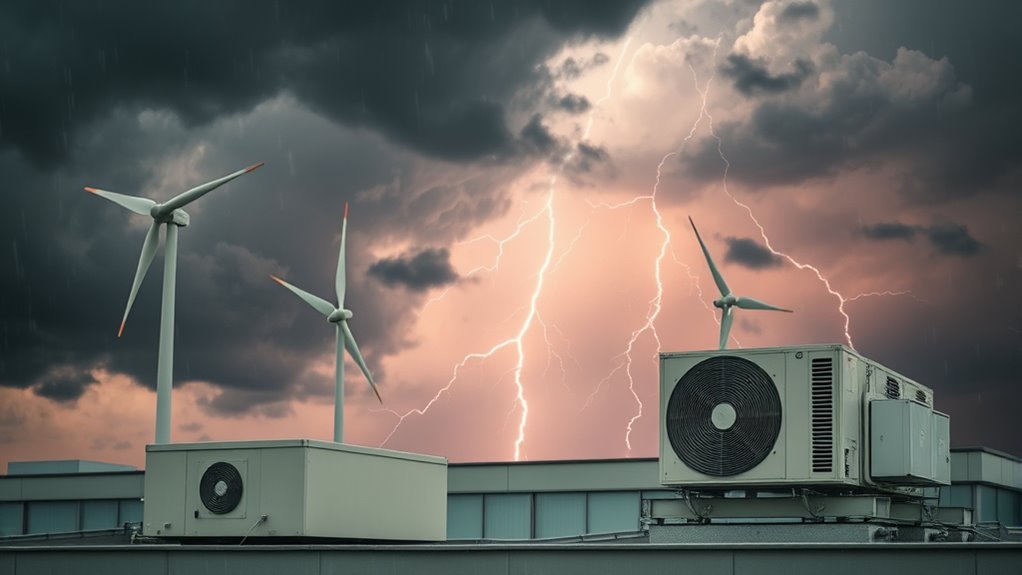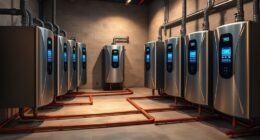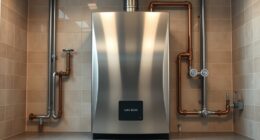To adapt your HVAC system for extreme weather, focus on improving insulation to stabilize indoor temperatures and reduce energy use. Smart thermostats can automatically respond to sudden changes, helping you stay comfortable and save energy. Upgrading your system with weather-resistant features and monitoring tools guarantees resilience during storms or heatwaves. By combining these strategies, you boost efficiency and comfort; keep exploring to discover more ways to make your HVAC system weather-ready.
Key Takeaways
- Upgrade insulation to stabilize indoor temperatures and reduce HVAC load during heatwaves and cold spells.
- Incorporate smart thermostats that automatically adjust settings based on weather changes for optimal comfort and efficiency.
- Use real-time energy monitoring to detect system issues early and optimize performance amid extreme conditions.
- Integrate weather data into HVAC controls for proactive adjustments during unpredictable weather events.
- Implement combined strategies of insulation improvements and smart controls to enhance resilience and reduce energy costs.

As buildings evolve to meet changing climate conditions and energy efficiency standards, adapting HVAC systems becomes essential. Extreme weather events, like heatwaves, cold snaps, and heavy storms, challenge the capabilities of traditional HVAC setups. To keep indoor environments comfortable and energy use optimized, you need to focus on strategies that enhance system resilience and efficiency. One key approach involves improving thermal insulation in your building. Well-installed insulation minimizes heat transfer, keeping indoor temperatures stable regardless of outside conditions. During scorching summers, it prevents cool air from escaping, reducing the strain on cooling systems. Conversely, in frigid spells, it retains warmth inside, easing the burden on heating units. This not only boosts comfort but also cuts energy costs and extends the lifespan of your HVAC equipment.
Alongside insulation, integrating smart thermostats plays a pivotal role in adapting your HVAC system to extreme weather. These devices learn your schedule and preferences, adjusting temperatures proactively to maintain comfort while optimizing energy consumption. During a sudden cold front, a smart thermostat can automatically increase the heating just before temperatures drop significantly, preventing uncomfortable indoor conditions. Similarly, during heatwaves, it can lower cooling demands by adjusting settings based on real-time weather data. The real advantage lies in their ability to be controlled remotely, allowing you to make adjustments on the go, even if you’re away. This level of control ensures your HVAC system responds swiftly to sudden weather shifts, preventing energy waste and maintaining a consistent indoor climate.
Smart thermostats adapt to weather changes, optimizing comfort and energy efficiency remotely.
Furthermore, smart thermostats often come with energy alerts and insights, helping you identify potential issues before they escalate. For example, if your system is working overtime during a mild day, it may signal a malfunction or an insulation problem that needs addressing. Regular updates and integration with weather forecasts mean your HVAC system can adapt dynamically, ensuring you’re prepared for upcoming weather extremes. Implementing energy-efficient solutions can further optimize system performance and reduce long-term operational costs. Combining thermal insulation improvements with smart thermostat technology creates a synergy that maximizes efficiency and resilience. It ensures your building remains comfortable without overworking your HVAC equipment, even during unexpected weather anomalies.
In essence, the key to adapting HVAC systems for extreme weather is proactive planning. Upgrading insulation and employing smart thermostats are smart moves that help your system respond effectively to climate challenges. These measures reduce energy consumption, lower costs, and improve comfort, ultimately making your building more resilient in the face of increasingly unpredictable weather patterns. By embracing these technologies and strategies now, you set yourself up for a more sustainable, efficient future, regardless of what weather conditions come your way.
Frequently Asked Questions
How Often Should HVAC Systems Be Inspected After Extreme Weather Events?
After extreme weather events, you should inspect your HVAC system immediately and then schedule preventive maintenance within a month. During these inspections, focus on system calibration to guarantee peak performance. Regular checks help identify damage early and prevent costly repairs. If you notice unusual noises, reduced efficiency, or leaks, get professional help promptly. Consistent inspections and preventive maintenance keep your HVAC system running smoothly despite weather challenges.
Can Existing HVAC Systems Be Retrofitted for Better Resilience?
Yes, you can definitely retrofit your existing HVAC system to boost resilience. Imagine transforming your old system into a fortress against extreme weather—adding smart thermostat upgrades and energy efficiency enhancements makes that possible. These upgrades improve performance, reduce energy waste, and help your system withstand storms or heatwaves. With some investment, your HVAC becomes smarter and tougher, ensuring comfort and reliability no matter what Mother Nature throws your way.
What Are the Signs of HVAC System Failure During Heatwaves or Cold Snaps?
During heatwaves or cold snaps, you’ll notice signs of HVAC system failure like system overload, where your unit struggles to maintain temperature, or refrigerant leaks, causing insufficient cooling or heating. You might hear unusual noises, see inconsistent airflow, or experience higher energy bills. If your system cycles frequently or won’t turn on, these are clear indicators it’s under stress and needs immediate inspection to prevent further damage.
How Do Outdoor Climate Conditions Affect HVAC Performance Long-Term?
Outdoor climate conditions shape your HVAC system like weathering stones in a river. Long-term, extreme heat or cold strains your system, making it work harder and less efficiently. Solar shading helps reduce heat gain, easing the load, while humidity control keeps indoor air comfortable despite outdoor moisture swings. Over time, these factors can cause wear and tear, so regular maintenance and adaptive systems are key to keeping your HVAC running smoothly.
Are There Specific HVAC Maintenance Tips for Hurricane-Prone Areas?
In hurricane-prone areas, you should implement storm-proofing strategies like securing outdoor units and elevating equipment. Regularly inspect and clean filters to guarantee efficient operation during storms. Consider installing emergency backup solutions, such as generators, to keep your HVAC system running when power outages occur. Additionally, seal ductwork to prevent water intrusion. These steps help maintain comfort and protect your system during extreme weather events.
Conclusion
By adapting your HVAC system for extreme weather, you’re not just protecting your home—you’re building a fortress against nature’s fury. With smart upgrades and proactive maintenance, you could withstand even the most intense heatwaves or cold snaps that threaten to turn your world upside down. Think of your system as a superhero shield, capable of defending your sanctuary against weather’s wildest attacks. Stay prepared, stay comfortable, and turn your home into an unbreakable haven amid the chaos.









